After removing the wristband and opening the case, the watchmaker demagnetizes the watch. A visual and technical examination gives him a first impression of the watch’s condition and accuracy. The watchmaker lifts the movement out of the case. The rotor, balance, and escapement are removed, cleaned, reassembled, and then oiled. The case is dismantled into its individual parts. During this process, the glass, seals, and other components, such as push buttons or rotating bezels, are removed. The case, metal bracelet, and clasp are ultrasonically cleaned in a special fluid. During the reassembly of the watch, all the seals are replaced in order to guarantee the watch’s water resistance.
〰
Service Steps
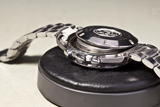
Step 1Opening of the case; dismantling of the crown with the winding stem so as to extract the movement with the dial and the hands.

Step 2An entry test to define the physical condition of the watch is required.
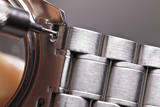
Step 3Removal of the bracelet.
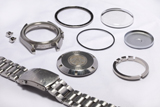
Step 4Dismantling of the case (glass, tube, pushers, helium escape valve, gaskets, bezel, etc).

Step 5Refurbishing of the case and bracelet in metal to original specifications (polishing, satin-finishing)

Step 6Cleaning (washing) of the case and bracelet in metal.
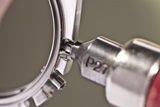
Step 7Assembling of the case and replacement of glass, tube, crown, pushers, helium escape valve, gaskets, if necessary.
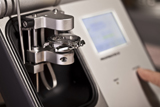
Step 8Restoration of water-resistance with above-mentioned spare parts.
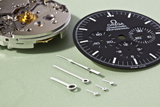
Step 9Dismantling of the dial and the hands from the movement.
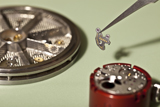
Step 10Dismantling of the movement into its individual parts.
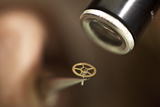
Step 11Identification of worn or damaged movement parts.
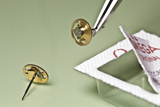
Step 12Repair or replacement of any faulty movement parts.

Step 13Cleaning (washing) of the disassembled movement in a machine with specific baths.
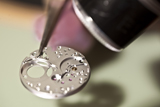
Step 14Checking the cleanliness of the movement.
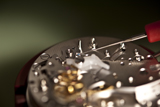
Step 15Assembling and oiling of the movement in accordance with SWISS specifications.
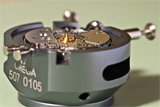
Step 16Checking of the functions of the movement in accordance with SWISS quality criteria.
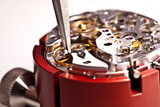
Step 17Adjustment of the rate.
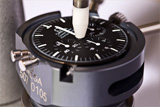
Step 18Fixing of the dial; replacement of the hands, if necessary.
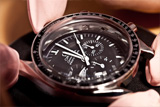
Step 19Casing up the movement equipped with the dial and the hands.
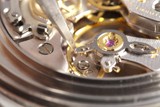
Step 20Full winding of a mechanical watch and tuning of the precision in accordance with SWISS standards.
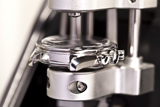
Step 21Closing of the case and checking of the water-resistance.
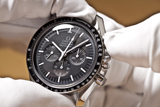
Step 22Setting of the correct time; checking the technical and aesthetic condition of the assembled watch.
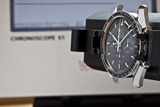
Step 23After 24 hours, checking to confirm that the precision and the rate are stable.
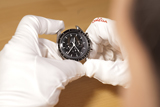
Step 24In order to check the power reserve of a mechanical watch, measurement of the hours of operation.
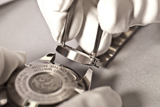
Step 25Fitting of the bracelet.
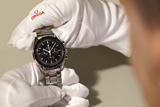
Step 26Final check before returning the watch to the customer.
〰
Frequently Asked Questions
Automatic watches need special handling. Although the manufacturers have their own ways of caring for their products, this article applies to every mechanical watch.
An automatic or a manual winding watch will stop if it is not worn for a few days. Wind up the crown to make it run again. Do not shake an automatic movement to get it running.
It’s best to wear a mechanical watch every day or every two days. Or put it in the Watch Winder. All the wheels need to be in motion because when in motion, the movement actually gets oily.
For a manual winding watch, try to wind up the watch at the same time every day. Set a routine, for example, every morning before putting it on. Turn the crown until you meet the resistance when winding the watch, including the self-winding watches. Remember to only turn the hands clockwise when setting the time. Take off the watch before you turn the crown. It is advisable to avoid turning the crown while wearing the timepiece as it may cause the winding stem to twist and damage the movement. It is recommended to rewind an automatic watch manually once a month, even when you wear it on a daily basis. Always set the day and/or date on the watch in the daytime. The mechanism on a day date watch is activated several hours during the night. Making adjustments during those hours could jam the mechanism.
Mechanical watches are designed to provide a lifetime of accurate and reliable service. For maximum efficiency and to prevent damage, a mechanical watch needs to be serviced every three or four years depending on the manufacturer’s recommendation. Because of the complexity of the mechanism in a fine mechanical watch, it’s best to have it serviced by an agent authorized by the watch manufacturer. They will inspect your watch for any worn parts that may need replacement, check whether it needs lubrication, and whether perspiration or water, dust, etc., needs to be removed from within the watch. A mechanical watch has to be serviced following the manufacturer’s instructions.
All mechanical watches need service, Many steps have to be performed to service a watch. First, the watch is opened and the movement is removed. It is taken apart, down to the very last screw. Then the parts are checked for wear and tear. The old parts are replaced when necessary. Then, all the parts are cleaned, reassembled, and lubricated. After those steps the movement is regulated, so the watch will run accordingly. If the watch is water resistant, the water tightness is checked. The last step is polishing the case and the bracelet. After performing all these steps, you will get almost a brand-new watch.
There are some good reasons. First, the oil that keeps the watch running will break over time. Unlubricated watch parts can create friction. The problem gets worse if the friction creates microscopic fine dust that will act as an abrasive to the movement. Another reason is that the watch’s case expands in response to hot and cold. This allows dust to enter the case through the microscopic fine cracks. This happens even in water-resistant watches that have protective gaskets.
Stainless steel bracelets should be washed carefully in water. If really dirty, use a soft toothbrush with soap and water to brush away the dirt. Finally, rinse with water and dry carefully with a soft cloth. Leather straps should be slightly loosened in the summer, when they may absorb perspiration. A tight strap not only prevents the passage of air over the strap undersurface but can also cause a perspiration rash on the wrist. If the strap ever becomes wet with perspiration, wipe it dry with a soft cloth. When you take off your watch, leave it in a well-ventilated spot. Never put it in a sealed container when it is still damp with perspiration. Avoid leaving your watch in direct sunlight. The strap color may fade. Make sure to change a metal bracelet or leather strap that is in a bad shape. It may brake at a certain point and you will risk losing or damaging your watch as a result.
Your watch is a precision measuring instrument. Treat it carefully, and it will serve you well. Avoid undue shocks (such as dropping on hard surfaces).
As a matter of principle, avoid exposing your wristwatch to magnetic fields for any length of time. All mechanical movements contain parts that can be magnetized, depending on the strength of the field. The German industrial standard DIN 8309 states that a mechanical watch is antimagnetic if it can be exposed to a magnetic field of strength 4800 A/m (the equivalent of 6 Militesla (mT)) and subsequently shows no major signs of impaired functionality. Certain models feature additional protection from magnetic fields in the form of a soft-iron inner case. This provides them with considerably more effective shielding against magnetic fields. However, if your watch should ever become magnetized and, as a result, inaccurate, our service is able to demagnetize the watch quickly and simply.
As a matter of principle, you should avoid strong vibrations and impacts (e.g. when playing golf or tennis, mountain biking etc.). A mechanical wristwatch is a precision instrument whose manufacture involves working to tolerances of hundredths or even thousandths of a millimetre. Repeated sharp impacts can have a negative influence on the movement’s accuracy or even cause damage.
When not being worn your watch should be stored in a dry environment away from direct heat and dust sources. Do not rest your mechanical watch on the crown or push pieces when you put it down as this can cause damage. Purpose built watch boxes make the perfect gift for the watch enthusiast as they store multiple pieces safely. Watch winders are a great storage solution for automatic watches. They contain a rotating mechanism to keep the watch working. However, do not use this all the time because it wears out the mechanism of your watch. Only use it to wind up the mechanism as much as needed.
If the watch is provided with a manual, make sure to find proper recommendations about sporting activities. In general, it is better to take of a mechanical timepiece while practicing such sports as golf or tennis that involve sudden or strong movements. Quartz watches are more suitable for sports activities. The quartz module is more robust. As for leather bands, they are not suitable to wear when you are practicing sports. It is better to wear watches that go on rubber, metal or acrylic bracelets.
To keep your watch running at its best, avoid these harmful environmental factors:
Stay clear of strong magnetic fields. You could magnetize your watch inadvertently and cause erratic gear behavior. The watch may also stop entirely! Most modern-day mechanical watches have some magnetic resistance, but you should still be careful. If you have an older watch, it may be more at risk.
If you can avoid it, do not wear your watch in extreme temperatures. Moving between excessive hot and cold temperatures can cause the parts to expand or contract,which may cause damage to the whole unit. Keeping your watch in extreme heat for too long can also cause your watch’s lubricant to congeal, causing friction on the gears. Just because a watch is “scratch-resistant” does not mean it is “scratch-proof.” Avoid harmful objects that can scratch your watch, as well as dirt and chemicals that can cause damage slowly over time. Avoiding dirt and chemicals will also prevent rusting.
〰
Other Information
Watches are made to wear on your wrists and, as such, will be subjected to some wear and tear. However, protect your watch from any impact, even if it is shock-proof. Contact with detergents, perfumes, solvents, etc., should also be avoided, as they could corrode the watch. Most importantly, if you are not using your watch, store it in a dry place on a soft surface, away from any extreme temperatures.
It is essential to clean the watch occasionally to maximize its life, performance and appearance. Use a soft, dry cloth to wipe off dirt, perspiration and water. Take care not to snag the crown or the pushers on the cloth fibers.
Apart from self-care and cleaning, it is vital to the long term functioning of the watch that it is serviced professionally from time to time. Depending on the use and the climatic conditions it is subjected to, a watch needs to be serviced once every 5 years. Routine servicing ensures that the mechanical components are working fine, the scratches are removed and that it remains water resistant.
It is essential to be aware of and understand your watch’s water resistance level. Unless your watch is rated explicitly as water resistant, it should be shielded from all sources of moisture, including excessive perspiration.
Regardless of the rating, always try to avoid rapid changes in pressure, as your watch needs a little time to adjust. Never submerge your watch in hot water or take hot baths while wearing it. This will cause the rubber seals to contract, and water may leak in.
Always check that your screw-down crown and buttons are tightly closed before entering the water. Generally, it’s good to avoid water contact, and when it happens, you must clean your watch with tap water and dry it with a soft cloth so all salt or chemical remains (from soap or shower gel) are removed. Salt and chemicals lead to seal corrosion and reduce their sealing ability.
Complete disassembly of the watch. Completely disassembled, cleaned, oiled, and timed
Clean all moving parts with specialized cleaning solvents
Proper lubrication with only the highest grade lubricants and oils during the reassembly process.
Thorough accuracy testing. Your watch is tested to our exacting standards over 72 hours to assure accuracy, water resistance, and proper operation of all functionality.
How should a watch be maintained in good condition?
Certain rules should be observed at different stages to maintain your watch in good condition:
- Water resistance
- The movement
- External cleaning
- Leather straps
- Metal bracelets
- Specific indications
Our Clean Factory Rolex is made to very high standards of quality. The mechanical parts run 24 hours a day when used, so the watch must undergo regular maintenance to ensure long life and good operation.
Periodically check the water resistance of your watch and have it reconditioned every five years or, in any case, each time the watch is opened. The reconditioning of the water resistance requires the replacement of the sealing gasket to guarantee maximum water resistance and safety. In cases where the watch frequently comes into contact with water for diving or other sports activities, we recommend an annual inspection.
To keep your watch in good working order, have its movement inspected every five years.
If the watch is significantly fast or slow, it may be necessary to regulate the movement.
To keep your watch in good condition externally, we recommend washing it with lukewarm, soapy water using a soft brush. After this process, as after each immersion in the sea or a swimming pool, thoroughly rinse the watch with fresh water. We recommend you clean your watch with a soft, dry cloth.
The straps must be washed with lukewarm water and left to dry. They should not be dried on a warm surface since the rapid evaporation of water might damage their shape and quality. After each immersion in the sea or swimming pool, thoroughly rinse the strap with fresh water.
The bracelets should be washed with lukewarm, soapy water using a soft brush. After this process, as after each immersion in the sea or swimming pool, thoroughly rinse the bracelet with fresh water and dry it with a soft, dry cloth.
a) Never operate the winding crown under water;
b) Never use the watch at a depth greater than that indicated.
How can I maintain the water resistance of this super clone Rolex watches over time?
A watch’s water resistance should be checked every five years.
We recommend an annual inspection for watches that frequently come into contact with water during diving or other sports activities.
What is excluded from the Clean Factory guarantee/limited warranty?
The Clean Factory guarantee/limited warranty does not include:
loss of water resistance more than 60 months after the date of purchase;
damage resulting from accidental impacts, improper or abusive use (shocks, crushing, oxidation, etc.), alterations due to exposure to strong magnetic fields or high temperatures, unauthorized repairs or manipulations, as well as the consequences of the normal wear and tear and aging of the watch and strap; theft or loss.
